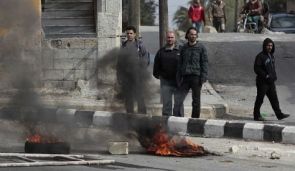Syrian Security Forces Kill 81 Protesters
BEIRUT, Lebanon — Security forces in Syria met thousands of demonstrators with fusillades of live ammunition after noon prayers on Friday, killing at least 81 people in the bloodiest day of the five-week-old Syrian uprising, according to protesters, witnesses and accounts on social networking sites.
From the Mediterranean coast and Kurdish east to the steppe of the Houran in southern Syria, protesters gathered in at least 20 cities and towns, including in the outskirts of the capital, Damascus. Cries for vengeance intersected with calls for the government’s fall, marking a potentially dangerous new dynamic in the revolt.
“We want revenge, and we want blood,” said Abu Mohamed, a protester in Azra, a southern town that had the highest death toll Friday. “Blood for blood.”
The breadth of the protests — and people’s willingness to defy security forces who were deployed en masse — painted a picture of turmoil in one of the Arab world’s most authoritarian countries. In scenes unprecedented only weeks ago, protesters tore down pictures of PresidentBashar al-Assad and toppled statues of his father, Hafez, in two towns on the capital’s outskirts, according to witnesses and video footage.
But despite the bloodshed, which promised to unleash another day of unrest as the dead are buried Saturday, the scale of the protests, so far, seemed to fall short of the popular upheaval of revolutions in Egypt and Tunisia. Organizers said the movement was still in its infancy, and the government, building on 40 years of institutional inertia, still commanded the loyalty of the military, economic elite and sizable minorities of Christian and heterodox Muslim sects who fear the state’s collapse.
Coming a day after Mr. Assad endorsed the lifting of draconian emergency rule, the killings represented another chapter in the government’s strategy of alternating promises of concessions with a grim crackdown that has left it staggering but still entrenched.
“There are indications the regime is scared, and this is adding to the momentum, but this is still the beginning,” said Wissam Tarif, the executive director of Insan, a Syrian human rights group. “Definitely, we haven’t seen the millions we saw in Egypt or Tunisia. The numbers are still humble, and it’s a reality we have to acknowledge.”
The images of carnage marked one of the deadliest days of the so-called Arab Spring, and the coming days may be replete with its lessons. In other places in the Middle East, violence has led to funerals where many more are often killed. The government’s belated attempts at reform, meanwhile, have often simply escalated protesters’ demands.
In that, the government faces perhaps its greatest challenge: to maintain its bastions of support with promises for the future and threats that its collapse means chaos, against the momentum that the vivid symbols of martyrdom have so often encouraged.
“We are not scared anymore,” said Abu Nadim, a protester in Douma, a town on the outskirts of Damascus. “We are sad and we are disappointed at this regime and at the president. Protests, demonstrations and death are now part of the daily routine.”
Click here to read more.


